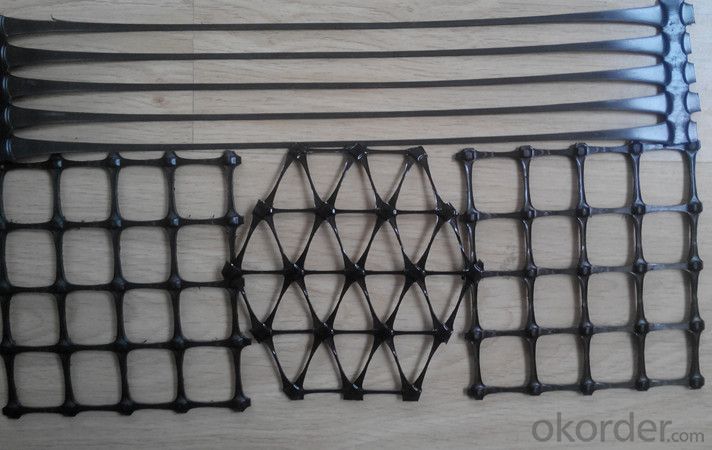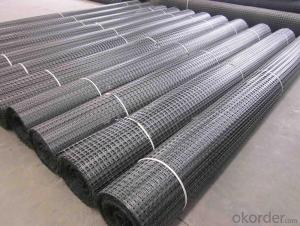Geogrids Nptel Plastic Uniaxial Geogrid for Geosynthetic Stabilization
- Loading Port:
- Tianjin
- Payment Terms:
- TT OR LC
- Min Order Qty:
- 500 m²
- Supply Capability:
- 100000 m²/month
OKorder Service Pledge
OKorder Financial Service
You Might Also Like
(ux) uniaxial geogrids
PP Uniaxial geogrid is expecially designed for soil reinforcement.it is sheet extruded,punched,heated and stretched from polypropylene,it has high tensile strength,excellent interlock capacity and deformation.
Speicification of PP Uniaxial Geogrid
| Property | TGDG | TGDG | TGDG | TGDG | TGDG | TGDG | |
| 35 | 50 | 80 | 100 | 110 | 120 | ||
| Ultimate tensile strength | kN/m | 35 | 50 | 80 | 100 | 110 | 120 |
| Elongation at maximum load | % | 10 | |||||
| Tensile strength at 2 % elongation | kN/m | 9 | 10 | 23 | 29 | 30 | 35 |
| Tensile strength at 5 % elongation | kN/m | 18 | 25 | 44 | 55 | 58 | 65 |
| Creep Limit Strength | KN/m | 15 | 21 | 30 | 39 | 40 | 46 |
| Minimum Carbon Black | % | 2 | |||||
| Property | TGDG 150 | TGDG | TGDG | TGDG | TGDG | TGDG | |
| 170 | 200 | 220 | 240 | 300 | |||
| Ultimate tensile strength | kN/m | 150 | 170 | 200 | 220 | 240 | 300 |
| Elongation at maximum load | % | 10 | |||||
| Tensile strength at 2 % elongation | kN/m | 39 | 45 | 55 | 59 | 65 | 90 |
| Tensile strength at 5 % elongation | kN/m | 77 | 90 | 110 | 120 | 132 | 182 |
| Creep Limit Strength | KN/m | 49 | 57 | 64 | 71.5 | 79 | 100 |
| Minimum Carbon Black | % | 2 | |||||
| Standard Roll Dimensions | |||||||
| Roll Length(m) | 50m | ||||||
| Roll Width(m) | 1m,2m,3m | ||||||








FAQ
1. How about the delivery time?
Lead time since receipt of 30% T/T deposit payment: 3 weeks.
2. What kind of payments does jenor support?
T/T, L/C, Cash are accepted.
3. What's are the MOQ?
We can according to your condition to set the MOQ.
And we can provide you samples for quality inspection.
4. Do you charge for the samples?
Accordeing to our company policy, the samples are freee, we only charge the freight fee. And we will return the freight fee If you set the order .
5. Can you produce the product according to customers' requirements ?
Sure, we are professional manufacturer, OEM and ODM are both welcome.
6. Can you tell me your main customers?
That's our customers' privacy, we should protect their information. At the same time, please rest assured that your information is also safe here.
- Q: What is the action mechanism of OKorder geogrid
- Glass fiber geogrid / glass fiber grille with glass fiber rovings as main raw materials, the reticular structure material of the knitting process, for the protection of glass fiber, improve the overall performance, through a special coating treatment process and the formation of new excellent geotechnical materials. Glass fiber has high heat resistance and excellent cold resistance, high strength, high modulus, good chemical stability, corrosion resistance, low coefficient of expansion, good dimensional stability and so on
- Q: Are geogrids suitable for use in railway trackbed stabilization?
- Yes, geogrids are suitable for use in railway trackbed stabilization. Geogrids provide reinforcement and stabilization to the trackbed by distributing loads, reducing settlement, and improving overall performance and longevity of the railway tracks.
- Q: Are geogrids suitable for use in high water table areas?
- Yes, geogrids are suitable for use in high water table areas. Geogrids are commonly used in construction and civil engineering projects to provide soil stabilization and reinforcement. They are designed to withstand high water table conditions, making them an effective solution in such areas. Geogrids can help distribute loads, increase soil strength, and prevent soil erosion, making them a reliable choice for projects in high water table areas.
- Q: Urgent need!!
- Geotextiles are used for road, railway, tunnel, dam, tailings treatment, isolation, filtration, drainage, reinforcement, protection and enhancement...Analysis of the causes of cracks in the asphalt overlay, the formation of a new type of excellent geotechnical substrates by special coating process.Asphalt overlay on old cement concrete pavement is a kind of special pavement structure, and its stress and strain characteristics are quite different from those of general elastic layered system.
- Q: Are there any specific requirements for geogrid installation in road construction?
- Yes, there are specific requirements for geogrid installation in road construction. These requirements include properly preparing the subgrade, ensuring proper tensioning and alignment of the geogrid, using appropriate anchoring and connection methods, and conducting regular inspections to ensure the geogrid remains in place and functions effectively. Additionally, the geogrid should be installed according to the manufacturer's recommendations and in compliance with industry standards and specifications.
- Q: Can geogrids be used in ground reinforcement for military installations?
- Yes, geogrids can be used in ground reinforcement for military installations. Geogrids are often employed in various civil engineering applications, including military projects, to enhance soil stability, provide load-bearing support, and improve overall ground reinforcement. They are effective in reinforcing and stabilizing soil, which is essential for military installations that require durable and resilient foundations to withstand heavy equipment, traffic, and potential ground disturbances. Geogrids can also assist in reducing soil erosion, enhancing slope stability, and minimizing the risk of ground movement or settlement, making them a valuable tool in military construction and infrastructure projects.
- Q: Are geogrids easy to install?
- Yes, geogrids are relatively easy to install. They can be laid directly onto the ground or embedded within the soil, depending on the specific application. The installation process typically involves preparing the area, placing the geogrid, and securing it in place. With proper planning and following the manufacturer's instructions, geogrid installation can be straightforward.
- Q: Are geogrids suitable for reinforcing railway subgrades?
- Yes, geogrids are suitable for reinforcing railway subgrades. Geogrids help to improve the stability and load-bearing capacity of the subgrade by distributing the loads more evenly. They also reduce soil movement, improve drainage, and prevent the formation of cracks and settlement. Overall, geogrids can significantly enhance the performance and longevity of railway subgrades.
- Q: What is the meaning of 80 in geogrid TGSG80
- A model can be viewed as a double grid
- Q: Can geogrids be used in stabilization of coastal dunes?
- Yes, geogrids can be used in the stabilization of coastal dunes. Geogrids are commonly used for soil reinforcement and erosion control, making them effective in preventing dune erosion and maintaining their stability. By installing geogrids, the dune's natural sand and vegetation can be retained, while preventing sand displacement and erosion caused by wind and waves.
Send your message to us
Geogrids Nptel Plastic Uniaxial Geogrid for Geosynthetic Stabilization
- Loading Port:
- Tianjin
- Payment Terms:
- TT OR LC
- Min Order Qty:
- 500 m²
- Supply Capability:
- 100000 m²/month
OKorder Service Pledge
OKorder Financial Service
Similar products
Hot products
Hot Searches
Related keywords






























